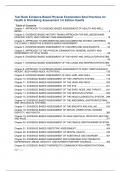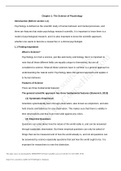Test Bank Evidence-Based Physical Examination Best Practices for
Health & Well-Being Assessment 1st Edition Gawlik
Table of Contents
Chapter 1. APPROACH TO EVIDENCE-BASED ASSESSMENT OF HEALTH AND WELL-
BEING ......................................................................................................................................... 3
Chapter 2. EVIDENCE-BASED HISTORY-TAKING APPROACH FOR WELLNESS EXAMS,
EPISODIC VISITS, AND CHRONIC CARE MANAGEMENT ..................................................... 18
Chapter 3. APPROACH TO IMPLEMENTING AND DOCUMENTING PATIENT- CENTERED,
CULTURALLY SENSITIVE EVIDENCE-BASED ASSESSMENT .............................................. 35
Chapter 4. EVIDENCE-BASED ASSESSMENT OF CHILDREN AND ADOLESCENTS ............ 53
Chapter 5. APPROACH TO THE PHYSICAL EXAMINATION: GENERAL SURVEY AND
ASSESSMENT OF VITAL SIGNS ............................................................................................. 68
Chapter 6. EVIDENCE-BASED ASSESSMENT OF THE HEART AND CIRCULATORY SYSTEM
.................................................................................................................................................. 93
Chapter 7. EVIDENCE-BASED ASSESSMENT OF THE LUNGS AND RESPIRATORY SYSTEM
................................................................................................................................................ 114
Chapter 8. APPROACH TO EVIDENCE-BASED ASSESSMENT OF BODY HABITUS (HEIGHT,
WEIGHT, BODY MASS INDEX, NUTRITION) ......................................................................... 135
Chapter 9. EVIDENCE-BASED ASSESSMENT OF SKIN, HAIR, AND NAILS ........................ 152
Chapter 10. EVIDENCE-BASED ASSESSMENT OF THE LYMPHATIC SYSTEM .................. 176
Chapter 11. EVIDENCE-BASED ASSESSMENT OF THE HEAD AND NECK ........................ 200
Chapter 12. EVIDENCE-BASED ASSESSMENT OF THE EYE .............................................. 221
Chapter 13. EVIDENCE-BASED ASSESSMENT OF THE EARS, NOSE, AND THROAT ....... 241
Chapter 14. EVIDENCE-BASED ASSESSMENT OF THE NERVOUS SYSTEM .................... 262
Chapter 15. EVIDENCE-BASED ASSESSMENT OF THE MUSCULOSKELETAL SYSTEM ... 289
Chapter 16. EVIDENCE-BASED ASSESSMENT OF THE ABDOMINAL,GASTROINTESTINAL,
AND UROLOGICAL SYSTEMS .............................................................................................. 317
Chapter 17. EVIDENCE-BASED ASSESSMENT OF THE BREASTS AND AXILLAE ............. 335
Chapter 18. EVIDENCE-BASED ASSESSMENT OF SEXUAL ORIENTATION, GENDER
IDENTITY, AND HEALTH ....................................................................................................... 360
Chapter 19. EVIDENCE-BASED ASSESSMENT OF MALE GENITALIA, PROSTATE, RECTUM,
AND ANUS ............................................................................................................................. 377
Chapter 20. EVIDENCE-BASED ASSESSMENT OF THE FEMALE GENITOURINARY SYSTEM
................................................................................................................................................ 397
Chapter 21. EVIDENCE-BASED OBSTETRIC ASSESSMENT ............................................... 424
Chapter 22. EVIDENCE-BASED ASSESSMENT OF MENTAL HEALTH ................................ 440
Chapter 23. EVIDENCE-BASED ASSESSMENT OF SUBSTANCE USE DISORDER ............ 457
Chapter 24. EVIDENCE-BASED ASSESSMENT AND SCREENING FOR TRAUMATIC
EXPERIENCES: ABUSE, NEGLECT, AND INTIMATE PARTNER VIOLENCE ....................... 463
Chapter 25. EVIDENCE-BASED THERAPEUTIC COMMUNICATION ANDMOTIVATIONAL
1|Page
,INTERVIEWING IN HEALTH ASSESSMENT ......................................................................... 470
Chapter 26. EVIDENCE-BASED HISTORY AND PHYSICAL EXAMINATIONS FOR SPORTS
PARTICIPATION EVALUATION ............................................................................................. 495
Chapter 27. USING HEALTH TECHNOLOGY IN EVIDENCE-BASED ASSESSMENT ........... 515
Chapter 28. EVIDENCE-BASED ASSESSMENT OF PERSONAL HEALTH AND WELL-BEING
FOR CLINICIANS: KEY STRATEGIES TO ACHIEVE OPTIMAL WELLNESS ........................ 531
Chapter 29. EVIDENCE-BASED HEALTH AND WELL-BEING ASSESSMENT: PUTTINGIT ALL
TOGETHER ............................................................................................................................ 551
2|Page
,Chapter 1. APPROACH TO EVIDENCE-BASED ASSESSMENT OF HEALTH AND
WELL- BEING
MULTIPLE CHOICE
1. After completing an initial assessment of a patient, the nurse has charted that his
respirationsare eupneic and his pulse is 58 beats per minute. These types of data would
be:
a Objective.
.
b Reflective.
.
c Subjective.
.
d Introspective.
.
ANS: A
Objective data are what the health professional observes by inspecting, percussing,
palpating, and auscultating during the physical examination. Subjective data is what the
person says about him or herself during history taking. The terms reflective and
introspective are not used to describe data.
DIF: Cognitive Level: Understanding (Comprehension) REF: z. 2
MSC: Client Needs: Safe and Effective Care Environment: Management of Care
2. A patient tells the nurse that he is very nervous, is nauseated, and feels hot. These
types of data would be:
a Objective.
.
b Reflective.
.
c Subjective.
.
d Introspective.
.
ANS: C
Subjective data are what the person says about him or herself during history taking. Objective
data are what the health professional observes by inspecting, percussing, palpating, and
auscultating during the physical examination. The terms reflective and introspective are not
used to describe data.
DIF: Cognitive Level: Understanding (Comprehension) REF: z. 2
3|Page
, MSC: Client Needs: Safe and Effective Care Environment: Management of Care
3. The patients record, laboratory studies, objective data, and subjective data combine to
form the:
a Data base.
.
b Admitting data.
.
c Financial statement.
.
d Discharge summary.
.
ANS: A
Together with the patients record and laboratory studies, the objective and subjective data
form the data base. The other items are not part of the patients record, laboratory studies,
or data.
DIF: Cognitive Level: Remembering (Knowledge) REF: z. 2
MSC: Client Needs: Safe and Effective Care Environment: Management of Care
4. When listening to a patients breath sounds, the nurse is unsure of a sound that is
heard. The nurses next action should be to:
a Immediately notify the patients physician.
.
b Document the sound exactly as it was heard.
.
c Validate the data by asking a coworker to listen to the breath sounds.
.
d Assess again in 20 minutes to note whether the sound is still present.
.
ANS: C
When unsure of a sound heard while listening to a patients breath sounds, the nurse
validates the data to ensure accuracy. If the nurse has less experience in an area, then he
or she asks an expertto listen.
DIF: Cognitive Level: Analyzing (Analysis) REF: z. 2
MSC: Client Needs: Safe and Effective Care Environment: Management of Care
5. The nurse is conducting a class for new graduate nurses. During the teaching
session, the nurse should keep in mind that novice nurses, without a background of
skills and experiencefrom which to draw, are more likely to make their decisions using:
4|Page





